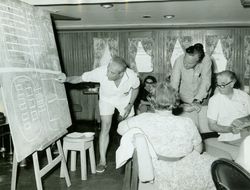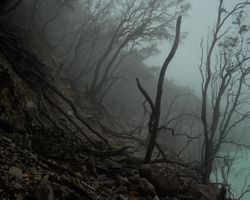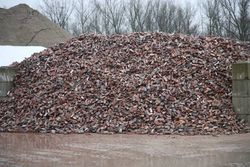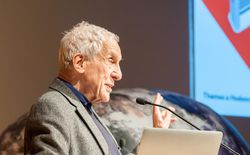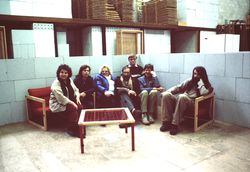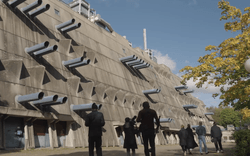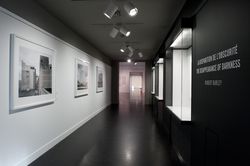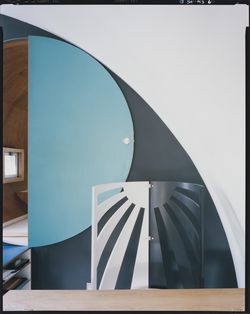In Response
In Response is a series of public seminars that mark the final weeks of the exhibition The Other Architect. If the exhibition presents alternative approaches and models that have challenged traditional design practices, the seminars offer alternative curatorial views on the exhibition and accompanying publication. Respondents include: Felicity Scott (Thursday 10 March),(...)
Main galleries
10 March 2016 to 1 April 2016
In Response
Actions:
Description:
In Response is a series of public seminars that mark the final weeks of the exhibition The Other Architect. If the exhibition presents alternative approaches and models that have challenged traditional design practices, the seminars offer alternative curatorial views on the exhibition and accompanying publication. Respondents include: Felicity Scott (Thursday 10 March),(...)
Main galleries
Bas Princen: Volcano Walks
In this artist’s talk, Bas Princen will discuss the current status of the 17 Volcanoes project and explore the resonances between the works of Franz Wilhelm Junghuhn, works by early-twentieth-century Dutch photographers in Java (like van Nieuwenhuis), and his own practice. Although discovering new places seems impossible today, the talk takes as a point of departure the(...)
15 October 2016, 3pm
Bas Princen: Volcano Walks
Actions:
Description:
In this artist’s talk, Bas Princen will discuss the current status of the 17 Volcanoes project and explore the resonances between the works of Franz Wilhelm Junghuhn, works by early-twentieth-century Dutch photographers in Java (like van Nieuwenhuis), and his own practice. Although discovering new places seems impossible today, the talk takes as a point of departure the(...)
archives
Level of archival description:
Collection
AP162
Synopsis:
The Die gläserne Kette CCA Collection documents the chain of correspondence exchanged between German architects Hermann Finsterlin, Paul Goesch, Wenzel Hablik, Hans Hansen, Carl Krayl, Hans and Wassili Luckhardt, Hans Scharoun, and Bruno and Max Taut between 1919 and 1920 on the subject of utopian architecture and society. This CCA collection features original copies and reproductions of the correspondence, as well as a limited number of drawings by the members of the group.
1911-1977
Die gläserne Kette collection
Actions:
AP162
Synopsis:
The Die gläserne Kette CCA Collection documents the chain of correspondence exchanged between German architects Hermann Finsterlin, Paul Goesch, Wenzel Hablik, Hans Hansen, Carl Krayl, Hans and Wassili Luckhardt, Hans Scharoun, and Bruno and Max Taut between 1919 and 1920 on the subject of utopian architecture and society. This CCA collection features original copies and reproductions of the correspondence, as well as a limited number of drawings by the members of the group.
archives
Level of archival description:
Collection AP162
1911-1977
Learning from... Brussels
Rotor members Michael Ghyoot and Maarten Gielen investigate the processes and practices of material management in Brussels and its suburbs. The concept of waste played a key role in their research and was informed by hundreds of visits to businesses, work sites, and recycling plants. The examination of discarded, unfinished products or those considered of inferior quality(...)
Paul Desmarais Theatre
19 April 2012 , 7pm
Learning from... Brussels
Actions:
Description:
Rotor members Michael Ghyoot and Maarten Gielen investigate the processes and practices of material management in Brussels and its suburbs. The concept of waste played a key role in their research and was informed by hundreds of visits to businesses, work sites, and recycling plants. The examination of discarded, unfinished products or those considered of inferior quality(...)
Paul Desmarais Theatre
drawings, textual records, born digital
AP181.S1.006
Description:
Original directory name: "05_Konsulenten". File contains records created and shared by COOP HIMMELB(L)AU and the various consultants on the project. These include PRO-Elektroplan GmbH, Bollinger+Grohmann, Dr. Pfeiler GmbH, Kersken + Kirchner GmbH., KBP Beratende Ingenieure GmbH, pbb planungsbüro balke, Ingenieurgemeinschaft BDP, a.g Licht, Realgruen Landschaftsarchitekten ,Lang + Burkhardt Verkehrsplanung und Städtebau, Emmer Pfenninger Partner AG, IB Rüdiger Schönenberg, Thomas A. Weisse + Partner. Bulk dates run from 2003-2006. Consultant expertise ranges from electricity, (electrical conveyor technology, Foerdertechnik) to structural physics (bauphysik), including open space planning (Freiflächenplanung), interior design (Inneneinrichtung), fire protection (Brandschutz), stage technology (Buehnentechnik), kitchen planning (Küchenplanung), facade engineering (Fassadentechnik), light design and planning (Lichtplaner), and solar panels for the roof. The records, largely plans, show the specific parts on which each of these consultants was working. The bulk of the records may be found under the “k_SSF_Ausführungsplanung/G_Pläne” directory which contains close to half of the records in this file. These are plans and views of the different areas and components of the BMW Welt building. These often include a CAD and a PDF version, some of which are annotated digitally or by hand prior to being digitized. CAD files include 2D drawings or 3D models, wireframes, screen captures, renderings, and plotter files. Records also include project management files, lists of the components of each room, engineering and analyses reports, many of which were digitized. Related to electrical and building engineering, there are a few databases in "c_PRO_Elektro_Foerdertechnik" and "b_KBP_Haustechnik". These contain information on the rooms and their technical requirements, such as equipment for plumbing, heat and ventilation, refrigeration systems, building automation, etc. Some database reports are also part of the records. Various sub-directories are named “quelldaten” (source data), which are typically zipped archives and often contain duplicate files. Duplicates were kept due to possible dependencies. Finally, the more than 7,000 plotter files across most directories suggest that printing physical copies of digital drawings for consultation was common practice. Early files (1997-2000) are AutoCAD Compiled Shape/Font File, AutoCAD Font Mapping Table, TrueType Font, and AutoCAD Colour-Dependant Plot Style Table. CAD files may depend on these to display drawings accurately. Most common file formats: Hewlett Packard Vector Graphic Plotter File, AutoCAD Drawing, Acrobat PDF 1.3 - Portable Document Format, Acrobat PDF 1.4 - Portable Document Format, ZIP Format
1996-2008
Consultants files for construction planning phase, BMW Welt, Munich
Actions:
AP181.S1.006
Description:
Original directory name: "05_Konsulenten". File contains records created and shared by COOP HIMMELB(L)AU and the various consultants on the project. These include PRO-Elektroplan GmbH, Bollinger+Grohmann, Dr. Pfeiler GmbH, Kersken + Kirchner GmbH., KBP Beratende Ingenieure GmbH, pbb planungsbüro balke, Ingenieurgemeinschaft BDP, a.g Licht, Realgruen Landschaftsarchitekten ,Lang + Burkhardt Verkehrsplanung und Städtebau, Emmer Pfenninger Partner AG, IB Rüdiger Schönenberg, Thomas A. Weisse + Partner. Bulk dates run from 2003-2006. Consultant expertise ranges from electricity, (electrical conveyor technology, Foerdertechnik) to structural physics (bauphysik), including open space planning (Freiflächenplanung), interior design (Inneneinrichtung), fire protection (Brandschutz), stage technology (Buehnentechnik), kitchen planning (Küchenplanung), facade engineering (Fassadentechnik), light design and planning (Lichtplaner), and solar panels for the roof. The records, largely plans, show the specific parts on which each of these consultants was working. The bulk of the records may be found under the “k_SSF_Ausführungsplanung/G_Pläne” directory which contains close to half of the records in this file. These are plans and views of the different areas and components of the BMW Welt building. These often include a CAD and a PDF version, some of which are annotated digitally or by hand prior to being digitized. CAD files include 2D drawings or 3D models, wireframes, screen captures, renderings, and plotter files. Records also include project management files, lists of the components of each room, engineering and analyses reports, many of which were digitized. Related to electrical and building engineering, there are a few databases in "c_PRO_Elektro_Foerdertechnik" and "b_KBP_Haustechnik". These contain information on the rooms and their technical requirements, such as equipment for plumbing, heat and ventilation, refrigeration systems, building automation, etc. Some database reports are also part of the records. Various sub-directories are named “quelldaten” (source data), which are typically zipped archives and often contain duplicate files. Duplicates were kept due to possible dependencies. Finally, the more than 7,000 plotter files across most directories suggest that printing physical copies of digital drawings for consultation was common practice. Early files (1997-2000) are AutoCAD Compiled Shape/Font File, AutoCAD Font Mapping Table, TrueType Font, and AutoCAD Colour-Dependant Plot Style Table. CAD files may depend on these to display drawings accurately. Most common file formats: Hewlett Packard Vector Graphic Plotter File, AutoCAD Drawing, Acrobat PDF 1.3 - Portable Document Format, Acrobat PDF 1.4 - Portable Document Format, ZIP Format
drawings, textual records, born digital
1996-2008
In this conversation, Kenneth Frampton (Columbia University) will discuss approaches to architectural history today with Esra Akcan (Cornell University) and Mark Jarzombek (Massachusetts Institute of Technology). What does it mean to write a global history of architecture now? What is the relationship between such a history and urgent contemporary concerns? During a(...)
6 April 2017
A Conversation with Kenneth Frampton: Can There Be a Global Architectural History Today?
Actions:
Description:
In this conversation, Kenneth Frampton (Columbia University) will discuss approaches to architectural history today with Esra Akcan (Cornell University) and Mark Jarzombek (Massachusetts Institute of Technology). What does it mean to write a global history of architecture now? What is the relationship between such a history and urgent contemporary concerns? During a(...)
Following an intense period of work in the mid-1970s with Portugal’s post-revolutionary housing initiatives, in the early 1980s Álvaro Siza contributed projects to two of the most important urban renewal programs in Europe: Berlin’s IBA and The Hague’s Stadsvernieuwing als Kulturel Aktiviteit (Urban Renewal as a Cultural Activity). This lecture will examine the(...)
26 November 2015
Álvaro Siza’s Archaeology of the Ordinary
Actions:
Description:
Following an intense period of work in the mid-1970s with Portugal’s post-revolutionary housing initiatives, in the early 1980s Álvaro Siza contributed projects to two of the most important urban renewal programs in Europe: Berlin’s IBA and The Hague’s Stadsvernieuwing als Kulturel Aktiviteit (Urban Renewal as a Cultural Activity). This lecture will examine the(...)
articles
Architecting a Change
Forces of Friction
9 December 2024
Architecting a Change
Federica Zambeletti in conversation with Arno Brandlhuber and Olaf Grawert
Actions:
Forces of Friction
The exhibition Robert Burley: The Disappearance of Darkness presents a series of photographs by Canadian artist Robert Burley, documenting the decline of traditional photographic equipment manufacturing brought on by new technologies. Since 2005, digital photographic technology has increasingly displaced its analog predecessor, resulting in a plummeting demand for(...)
Hall cases
11 September 2009 to 15 November 2009
Robert Burley: The Disappearance of Darkness
Actions:
Description:
The exhibition Robert Burley: The Disappearance of Darkness presents a series of photographs by Canadian artist Robert Burley, documenting the decline of traditional photographic equipment manufacturing brought on by new technologies. Since 2005, digital photographic technology has increasingly displaced its analog predecessor, resulting in a plummeting demand for(...)
Hall cases
Kazuo Shinohara was a deeply influential figure in postwar architecture in Japan best known for his individual houses, but he remains little studied today, especially outside Japan. Shinohara connected traditional forms and an investigation of modernist tenets with the high-tech and information technology moments yet to come. What was his attitude toward history, and how(...)
Paul Desmarais Theatre Keyword(s):
David B. Stewart, Kazuo Shinohara, What is/was history for…
21 September 2017, 6:30pm
David B. Stewart, what was history for Kazuo Shinohara?
Actions:
Description:
Kazuo Shinohara was a deeply influential figure in postwar architecture in Japan best known for his individual houses, but he remains little studied today, especially outside Japan. Shinohara connected traditional forms and an investigation of modernist tenets with the high-tech and information technology moments yet to come. What was his attitude toward history, and how(...)
Paul Desmarais Theatre Keyword(s):
David B. Stewart, Kazuo Shinohara, What is/was history for…
